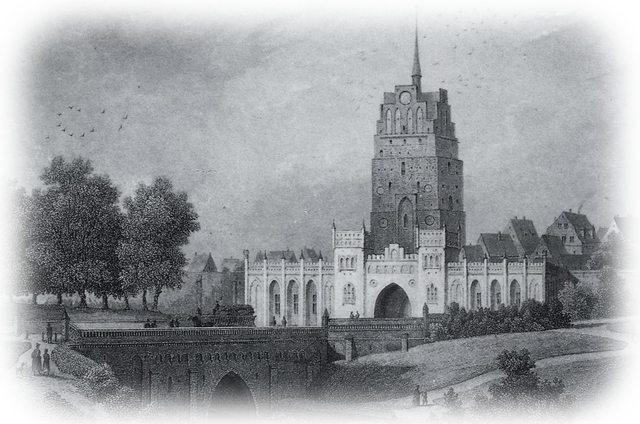The Kröpeliner gate has been built as the most
western one of four big gates of the city fortification
of Rostock around 1270 in the Gothic style. Even then it
was very big with its two floors. Also it is one of the most immense
ones partial up to 22 counting gates. Whether it was named to the
Mecklenburg provincial town Kröpelin
in whose direction it leads or after a patrician's gender of the same
name, is controversial till this day. It's situated at
the western end of the Kröpeliner
street, the main pedestrian area of the picturesque old town of Rostock.
Already 1255 it's reported about a wooden gate.
The later gate from stone was built at the same place in the course of
the establishment of a connection of Rostock with a wall, towers and
gates, after three original city centers 1265 officially joined. 1280
this was mentioned the first time. The original two floors are still
very well recognizable in the different colouring of the stones.

copper engraving, 1855
In the course of the time the gate was considerably extended. The
bourgeoisie of the town decided in 1400 on a heightening about 5 floors
on 54 meters. Because the gate stands at the street to Lübeck and
Wismar, it should provide for all commercial travelers the
Hanseatic size and meaning of the town.
In 1847, thus in the time in which the town borders started to
extend the establishment of a Gothic porch occurred. The
functionless gate became such a splendor building of the town.
When in 1905 a restoration took place, in addition, a griffin was
inserted in the big sharp curve screen of the field side. In contrast
to the surrounding destroyed buildings, the gate barely took
damage at the British bomb attacks at the end of April, 1942. In 1945,
although intact, the porch for aesthetic reasons was removed.
Besides, a piece of the town wall which applied to the north
of the gate up to fishing bastion and stood firm the bombs, ragged in
favour of never achieved traffic plannings. In addition, still till
1960 a tram line led through the gate.
The next restoration work took place from 1966 until 1969.
Since then it was the seat of the museum for town history. In 2004 it
was closed. Today it is the seat of the incorporated
historical society of Rostock.
In tracks of the masonry the cultivation of the
town wall is as recognizable, how the connections of the upper wooden
military way. The gate has no further contact with the wall. Plans, to
close this gap again, were rejected in April, 2006 by the office for
town planning. Instead, a partial course of the wall (although without
historical citations) became in connection with the construction of the
Kröpeliner
gate centre (Kröpeliner-Tor-Center KTC).